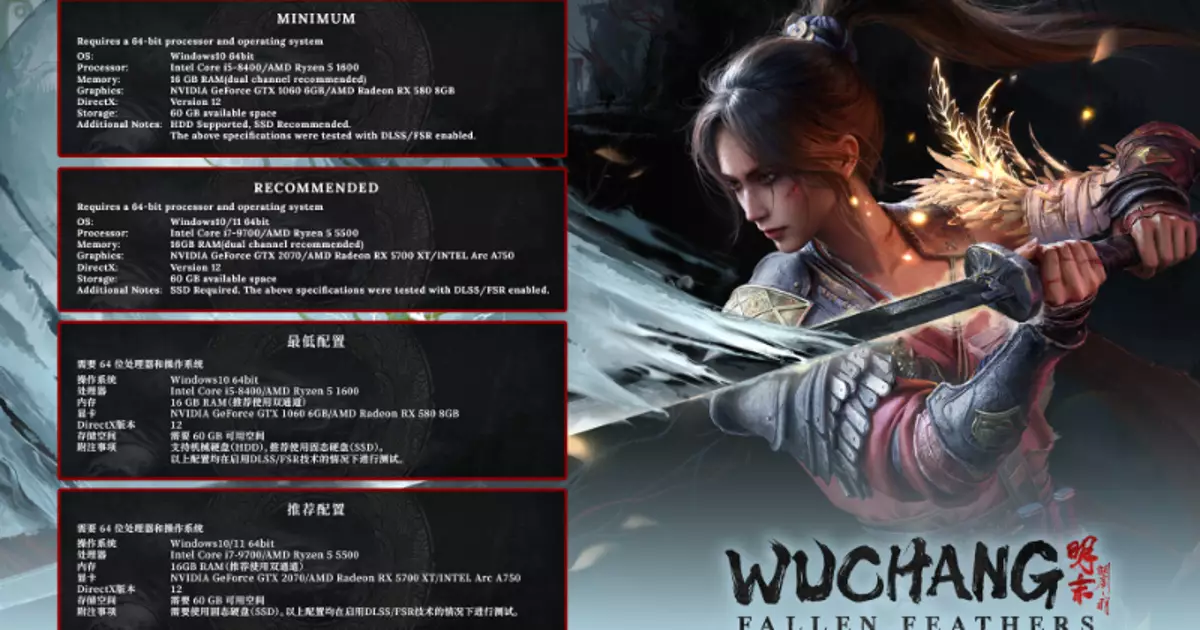Wuchang: Fallen Feathers promises more than pixelated battles; it offers an immersive journey into a reimagined Ming-era China plagued by supernatural affliction. Unlike typical titles that demand cutting-edge hardware, this game strikes a balance between stunning visual detail and accessible system requirements. The developers, Leenzee, have made conscious tweaks to the game’s aesthetic, shifting away from the more ominous, blood-soaked aesthetic reminiscent of Bloodborne into a more nuanced, atmospheric setting. This adjustment demonstrates a commitment to creating a world that respects artistic integrity while remaining welcoming to a broader player base. The game’s art style combines traditional Chinese motifs with gothic horror, creating a captivating environment that draws players into a realm teeming with monsters, mysteries, and mythic weaponry. Such a visual approach not only elevates the narrative but also exemplifies how strong artistic direction can compensate for hardware constraints, making the game accessible without sacrificing depth or beauty.
Gameplay Mechanics that Elevate the Action-RPG Genre
The core gameplay of Wuchang centers on dynamic combat, exploration, and decision-making that shape multiple endings. The protagonist, a amnesiac pirate swordswoman, embodies resilience and curiosity—driving players to uncover her lost past amidst the chaos of plumed mutations and monstrous bosses. The inclusion of “Red Mercury” as a resource to unlock new techniques and amplify weapon effects underscores the game’s emphasis on strategic progression. Unlike more linear titles, Wuchang offers a layered experience where every choice matters, from weapon enchantments to the trustworthiness of allies. This branching narrative model encourages replayability and deep engagement, challenging players to anticipate consequences and adapt.
Furthermore, the game’s combat mechanics are notably agile and responsive, harnessing a combat system that rewards timing, skill, and resource management. The emphasis on boss fights and upgrades signifies a traditional soulslike inspiration, but Wuchang’s unique setting and supernatural elements provide a fresh take. The game’s design makes it appealing both to die-hard fans of the genre and newcomers seeking a compelling narrative rooted in mythology and folklore. It elevates its genre by combining intricate combat systems with a richly textured world that demands both strategic thinking and emotional investment.
Hardware Requirements: Bridging Ambition with Accessibility
A notable aspect of Wuchang’s announcement revolves around its system requirements, which strike a commendable balance. Requiring only a modest Intel Core i5-8400 or AMD Ryzen 5 1600 processor and a GeForce GTX 1060 or Radeon RX 580 makes the game attainable for a significant portion of gamers. The developers have consciously designed the technical specifications so that performance bottlenecks are minimized, emphasizing that even mid-range hardware can deliver an engaging experience. The recommended specs, including an RTX 2070 or Radeon RX 5700 XT, with support for newer technologies like DLSS 4, suggest that the game can harness modern advancements for improved visuals and performance.
This philosophy of inclusivity signals a mature understanding of the gaming market—where accessibility and quality are not mutually exclusive. The game’s support for SSDs further demonstrates that Wuchang aims for smooth loading times and optimized performance, ensuring players aren’t hindered by technical limitations. The focus on hardware that can deliver a genuine experience on various configurations opens doors for a diverse player demographic eager to explore a beautifully crafted, action-packed universe without the need for exorbitant investment in high-end gear.
Personal Reflection: Why Wuchang Inspires Disruption in the Genre
From my perspective, Wuchang stands out not solely because of its technical specs or combat mechanics, but because of its ambitious narrative and cultural depth. Integrating Chinese mythology and folklore into the fabric of the game enriches the genre, providing a fresh lens through which players can experience a familiar gameplay formula. Its emphasis on player choice and multiple endings signals a mature storytelling approach that gives power to the player—an element often missing in AAA titles.
Yet, what truly excites me about Wuchang is its potential to redefine what audiences expect from action-RPGs. Instead of chasing after hyper-realistic visuals or overwhelming technical demands, it prioritizes atmospheric storytelling, strategic gameplay, and cultural authenticity. It exemplifies that beautiful worlds and complex mechanics do not require infinite processing power but rather thoughtful design. As it gears up to launch, Wuchang’s approach could inspire developers to rethink the axis of accessibility versus ambition—showing that innovation thrives when there’s a genuine respect for both player experience and artistic integrity.
By struggling to find the precise line between hardware demands and engaging content, Wuchang has the potential to leave a lasting mark—challenging the industry’s tendency to underdeliver or overreach. Instead, it offers a balanced, compelling vision of what modern action-RPGs can be: immersive, challenging, and inclusive.

